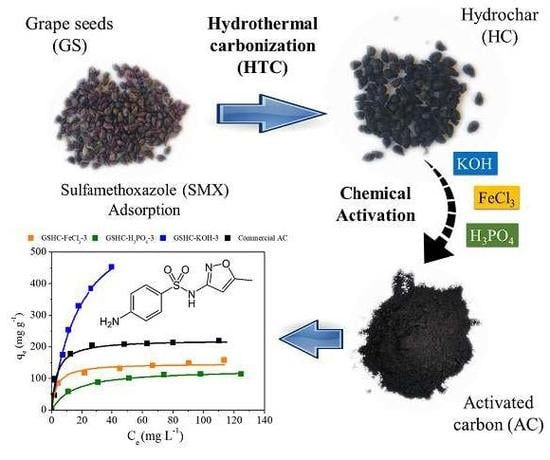Low-Cost Activated Grape Seed-Derived Hydrochar through Hydrothermal Carbonization and Chemical Activation for Sulfamethoxazole Adsorption
Abstract
Featured Application
Abstract
1. Introduction
2. Materials and Methods
2.1. Preparation of Hydrochars
2.2. Preparation of Activated Carbons
2.3. Characterization of Hydrochar and Activated Carbons
2.4. Adsorption Tests
3. Results and Discussion
3.1. Characterization of the Hydrochars
3.2. Activated Carbons by Chemical Activation of Hydrochars
3.3. Adsorption of Sulfamethoxazole
4. Conclusions
Supplementary Materials
Author Contributions
Funding
Conflicts of Interest
References
- Demirbas, A. Combustion characteristics of different biomass fuels. Prog. Energy Combust. Sci. 2004, 30, 219–230. [Google Scholar] [CrossRef]
- Goyal, H.B.; Seal, D.; Saxena, R.C. Biofuels from thermochemical conversion of renewable resources: A review. Renew. Sustain. Energy Rev. 2008, 12, 504–517. [Google Scholar] [CrossRef]
- Yip, K.; Tian, F.; Hayashi, J.-I.; Wu, H. Effect of alkali and alkaline earth metallic species on biochar reactivity and syngas compositions during steam gasification. Energy Fuel. 2009, 24, 173–181. [Google Scholar] [CrossRef]
- Saxena, R.; Adhikari, D.; Goyal, H. Biomass-based energy fuel through biochemical routes: A review. Renew. Sustain. Energy Rev. 2009, 13, 167–178. [Google Scholar] [CrossRef]
- Kambo, H.S.; Dutta, A. A comparative review of biochar and hydrochar in terms of production, physico-chemical properties and applications. Renew. Sustain. Energy Rev. 2015, 45, 359–378. [Google Scholar] [CrossRef]
- Berge, N.D.; Ro, K.S.; Mao, J.; Flora, J.R.V.; Chappell, M.A.; Bae, S. Hydrothermal carbonization of municipal waste streams. Environ. Sci. Technol. 2011, 45, 5696–5703. [Google Scholar] [CrossRef]
- Falco, C.; Marco-Lozar, J.P.; Salinas-Torres, D.; Morallón, E.; Cazorla-Amorós, D.; Titirici, M.M.; Lozano-Castelló, D. Tailoring the porosity of chemically activated hydrothermal carbons: Influence of the precursor and hydrothermal carbonization temperature. Carbon 2013, 62, 346–355. [Google Scholar] [CrossRef]
- Funke, A.; Ziegler, F. Hydrothermal carbonization of biomass: A summary and discussion of chemical mechanisms for process engineering. Biofuels Bioprod. Biorefin. 2010, 4, 160–177. [Google Scholar] [CrossRef]
- Hitzl, M.; Corma, A.; Pomares, F.; Renz, M. The hydrothermal carbonization (HTC) plant as a decentral biorefinery for wet biomass. Catal. Today 2015, 257, 154–159. [Google Scholar] [CrossRef]
- Hrnčič, M.K.; Kravanja, G.; Knez, Ž. Hydrothermal treatment of biomass for energy and chemicals. Energy 2016, 116, 1312–1322. [Google Scholar] [CrossRef]
- Sermyagina, E.; Saari, J.; Kaikko, J.; Vakkilainen, E. Hydrothermal carbonization of coniferous biomass: Effect of process parameters on mass and energy yields. J. Anal. Appl. Pyrolysis 2015, 113, 551–556. [Google Scholar] [CrossRef]
- Álvarez-Murillo, A.; Román, S.; Ledesma, B.; Sabio, E. Study of variables in energy densification of olive stone by hydrothermal carbonization. J. Anal. Appl. Pyrolysis 2015, 113, 307–314. [Google Scholar] [CrossRef]
- Román, S.; Nabais, J.M.V.; Laginhas, C.; Ledesma, B.; González, J.F. Hydrothermal carbonization as an effective way of densifying the energy content of biomass. Fuel Process. Technol. 2012, 103, 78–83. [Google Scholar] [CrossRef]
- Wüst, D.; Rodriguez Correa, C.; Suwelack, K.U.; Köhler, H.; Kruse, A. Hydrothermal carbonization of dry toilet residues as an added-value strategy—Investigation of process parameters. J. Environ. Manag. 2019, 234, 537–545. [Google Scholar] [CrossRef]
- De la Rubia, M.A.; Villamil, J.A.; Rodriguez, J.J.; Mohedano, A.F. Effect of inoculum source and initial concentration on the anaerobic digestion of the liquid fraction from hydrothermal carbonisation of sewage sludge. Renew. Energy 2018, 127, 697–704. [Google Scholar] [CrossRef]
- Villamil, J.A.; Mohedano, A.F.; Rodriguez, J.J.; De la Rubia, M.A. Anaerobic co-digestion of the aqueous phase from hydrothermally treated waste activated sludge with primary sewage sludge. J. Environ. Manag. 2019, 231, 726–733. [Google Scholar] [CrossRef]
- Bargmann, I.; Rillig, M.C.; Kruse, A.; Greef, J.-M.; Kücke, M. Effects of hydrochar application on the dynamics of soluble nitrogen in soils and on plant availability. J. Plant Nutr. Soil Sci. 2014, 177, 48–58. [Google Scholar] [CrossRef]
- Fernandez, M.E.; Ledesma, B.; Román, S.; Bonelli, P.R.; Cukierman, A.L. Development and characterization of activated hydrochars from orange peels as potential adsorbents for emerging organic contaminants. Bioresour. Technol. 2015, 183, 221–228. [Google Scholar] [CrossRef]
- Guo, S.; Dong, X.; Wu, T.; Zhu, C. Influence of reaction conditions and feedstock on hydrochar properties. Energy Convers. Manag. 2016, 123, 95–103. [Google Scholar] [CrossRef]
- Fang, J.; Zhan, L.; Ok, Y.S.; Gao, B. Minireview of potential applications of hydrochar derived from hydrothermal carbonization of biomass. J. Ind. Eng. Chem. 2018, 57, 15–21. [Google Scholar] [CrossRef]
- Heidari, M.; Dutta, A.; Acharya, B.; Mahmud, S. A review of the current knowledge and challenges of hydrothermal carbonization for biomass conversion. J. Energy Inst. 2019, 92, 1779–1799. [Google Scholar] [CrossRef]
- Nizamuddin, S.; Baloch, H.A.; Griffin, G.J.; Mubarak, N.M.; Bhutto, A.W.; Abro, R.; Mazari, S.A.; Ali, B.S. An overview of effect of process parameters on hydrothermal carbonization of biomass. Renew. Sustain. Energy Rev. 2017, 73, 1289–1299. [Google Scholar] [CrossRef]
- Titirici, M.M. Hydrothermal Carbons: Synthesis, Characterization, and Applications. In Novel Carbon Adsorbents, 1st ed.; Tascón, J.M.D., Ed.; Elsevier Ltd.: Oxford, UK, 2012; pp. 351–399. [Google Scholar]
- Fang, J.; Gao, B.; Zimmerman, A.R.; Ro, K.S.; Chen, J.J. Physically (CO2) activated hydrochars from hickory and peanut hull: Preparation, characterization, and sorption of methylene blue, lead, copper, and cadmium. RSC Adv. 2016, 6, 24906–24911. [Google Scholar] [CrossRef]
- Wang, B.; Gao, B.; Fang, J. Recent advances in engineered biochar productions and applications. Crit. Rev. Environ. Sci. Technol. 2017, 47, 2158–2207. [Google Scholar] [CrossRef]
- Aliakbari, Z.; Younesi, H.; Ghoreyshi, A.A.; Bahramifar, N.; Heidari, A. Sewage sludge-based activated carbon: Its application for hexavalent chromium from synthetic and electroplating wastewater in batch and fixed-bed column adsorption. Desalin. Water Treat. 2017, 93, 61–73. [Google Scholar] [CrossRef]
- Regmi, P.; Moscoso, J.L.G.; Kumar, S.; Cao, X.; Maob, J.; Schafran, G. Removal of copper and cadmium from aqueous solution using switchgrass biochar produced via hydrothermal carbonization process. J. Environ. Manag. 2012, 109, 61–69. [Google Scholar] [CrossRef]
- Zhang, X.; Zhang, L.; Li, A. Eucalyptus sawdust derived biochar generated by combining the hydrothermal carbonization and low concentration KOH modification for hexavalent chromium removal. J. Environ. Manag. 2018, 206, 989–998. [Google Scholar] [CrossRef]
- Islam, A.; Ahmed, M.J.; Khanday, W.A.; Asif, M.; Hameed, B.H. Mesoporous activated coconut shell-derived hydrochar prepared via hydrothermal carbonization-NaOH activation for methylene blue adsorption. J. Environ. Manag. 2017, 203, 237–244. [Google Scholar] [CrossRef]
- Jain, A.; Balasubramanian, R.; Srinivasan, M.P. Tuning hydrochar properties for enhanced mesopore development in activated carbon by hydrothermal carbonization. Microporous Mesoporous Mater. 2015, 203, 178–185. [Google Scholar] [CrossRef]
- Puccini, M.; Stefanelli, E.; Tasca, A.L.; Vitolo, S. Pollutant Removal from gaseous and aqueous phases using hydrochar-based activated carbon. Chem. Eng. Trans. 2018, 67, 637–642. [Google Scholar]
- Zhang, X.; Gao, B.; Fang, J.; Zou, W.; Dong, L.; Cao, C.; Zhang, J.; Li, Y.; Wang, H. Chemically activated hydrochar as an effective adsorbent for volatile organic compounds (VOCs). Chemosphere 2019, 218, 680–686. [Google Scholar] [CrossRef]
- Rodríguez-Correa, C.; Bernardo, M.; Ribeiro, R.P.P.L.; Esteves, I.A.A.C.; Kruse, A. Evaluation of hydrothermal carbonization as a preliminary step for the production of functional materials from biogas digestate. J. Anal. Appl. Pyrolysis 2017, 124, 461–474. [Google Scholar] [CrossRef]
- Xue, Y.; Gao, B.; Yao, Y.; Inyang, M.; Zhang, M.; Zimmerman, A.R.; Ro, K.S. Hydrogen peroxide modification enhances the ability of biochar (hydrochar) produced from hydrothermal carbonization of peanut hull to remove aqueous heavy metals: Batch and column tests. Chem. Eng. J. 2012, 200, 673–680. [Google Scholar] [CrossRef]
- Zhang, T.; Wu, X.; Fan, X.; Tsang, D.C.W.; Li, G.; Shen, Y. Corn waste valorization to generate activated hydrochar to recover ammonium nitrogen from compost leachate by hydrothermal assisted pretreatment. J. Environ. Manag. 2019, 236, 108–117. [Google Scholar] [CrossRef]
- Al Bahri, M.; Calvo, L.; Gilarranz, M.A.; Rodriguez, J.J. Activated carbon from grape seeds upon chemical activation with phosphoric acid: Application to the adsorption of diuron from water. Chem. Eng. J. 2012, 203, 348–356. [Google Scholar] [CrossRef]
- Al Bahri, M.; Calvo, L.; Gilarranz, M.A.; Rodriguez, J.J. Diuron multilayer adsorption on activated carbon from CO2 activation of grape seeds. Chem. Eng. Commun. 2016, 203, 103–113. [Google Scholar] [CrossRef]
- Jimenez-Cordero, D.; Heras, F.; Alonso-Morales, N.; Gilarranz, M.A.; Rodriguez, J.J. Porous structure and morphology of granular chars from flash and conventional pyrolysis of grape seeds. Biomass Bioenergy 2013, 54, 123–132. [Google Scholar] [CrossRef]
- Jimenez-Cordero, D.; Heras, F.; Gilarranz, M.A.; Raymundo-Piñero, E. Grape seed carbons for studying the influence of texture on supercapacitor behaviour in aqueous electrolytes. Carbon 2014, 71, 27–138. [Google Scholar] [CrossRef]
- Okman, I.; Karagöz, S.; Tay, T.; Erdem, M. Activated carbons from grape seeds by chemical activation with potassium carbonate and potassium hydroxide. Appl. Surf. Sci. 2014, 293, 138–142. [Google Scholar] [CrossRef]
- Purnomo, C.; Castello, D.; Fiori, L. Granular activated carbon from grape seeds hydrothermal char. Appl. Sci. 2018, 8, 331. [Google Scholar] [CrossRef]
- Park, K.Y.; Lee, K.; Kim, D. Characterized hydrochar of algal biomass for producing solid fuel through hydrothermal carbonization. Bioresour. Technol. 2018, 258, 119–124. [Google Scholar] [CrossRef]
- Iffland, K.; Sherwood, J.; Carus, M.; Raschka, A.; Farmer, T.; Clark, J. Calculation and Comparison of the “Biomass Utilization Efficiency (BUE)” of Various Bio-based Chemicals, Polymers and Fuels. Available online: http://bio-based.eu/?did=32321&vp_edd_act=show_download (accessed on 5 September 2019).
- Bedia, J.; Monsalvo, V.M.; Rodriguez, J.J.; Mohedano, A.F. Iron catalysts by chemical activation of sewage sludge with FeCl3 for CWPO. Chem. Eng. J. 2017, 318, 224–230. [Google Scholar] [CrossRef]
- Bedia, J.; Belver, C.; Ponce, S.; Rodriguez, J.; Rodriguez, J.J. Adsorption of antipyrine by activated carbons from FeCl3-activation of Tara gum. Chem. Eng. J. 2018, 333, 58–65. [Google Scholar] [CrossRef]
- Rosas, J.M.; Bedia, J.; Rodríguez-Mirasol, J.; Cordero, T. HEMP-derived activated carbon fibers by chemical activation with phosphoric acid. Fuel 2009, 88, 19–26. [Google Scholar] [CrossRef]
- Sevilla, M.; Ferrero, G.A.; Fuertes, A.B. Beyond KOH activation for the synthesis of superactivated carbons from hydrochar. Carbon N. Y. 2017, 114, 50–58. [Google Scholar] [CrossRef]
- Dubinin, M.M. Fundamentals of the theory of adsorption in micropores of carbon adsorbents: Characteristics of their adsorption properties and microporous structures. Carbon 1989, 27, 457–467. [Google Scholar] [CrossRef]
- Rey, A.; Zazo, J.A.; Casas, J.A.; Bahamonde, A.; Rodriguez, J.J. Influence of the structural and surface characteristics of activated carbon on the catalytic decomposition of hydrogen peroxide. Appl. Catal. A: Gen. 2011, 402, 146–155. [Google Scholar] [CrossRef]
- Sabio, E.; Álvarez-Murillo, A.; Román, S.; Ledesma, B. Conversion of tomato-peel waste into solid fuel by hydrothermal carbonization: Influence of the processing variables. Waste Manag. 2016, 47, 122–132. [Google Scholar] [CrossRef]
- Falco, C.; Baccile, N.; Titirici, M.M. Morphological and structural differences between glucose, cellulose and lignocellulosic biomass derived hydrothermal carbons. Green Chem. 2011, 13, 3273–3281. [Google Scholar] [CrossRef]
- Benstoem, F.; Becker, G.; Firk, J.; Kaless, M.; Wuest, D.; Pinnekamp, J.; Kruse, A. Elimination of micropollutants by activated carbon produced from fibers taken from wastewater screenings using hydrothermal carbonization. J. Environ. Manag. 2018, 211, 278–286. [Google Scholar] [CrossRef]
- Sevilla, M.; Fuertes, A.B. The production of carbon materials by hydrothermal carbonization of cellulose. Carbon N. Y. 2009, 47, 2281–2289. [Google Scholar] [CrossRef]
- Jian, X.; Zhuang, X.; Li, B.; Xu, X.; Wei, Z.; Song, Y.; Jiang, E. Comparison of characterization and adsorption of biochars produced from hydrothermal carbonization and pyrolysis. Environ. Technol. Innov. 2018, 10, 27–35. [Google Scholar] [CrossRef]
- Mena, I.F.; Diaz, E.; Moreno-Andrade, I.; Rodriguez, J.J.; Mohedano, A.F. Stability of carbon-supported iron catalysts for catalytic wet peroxide oxidation of ionic liquids. J. Environ. Chem. Eng. 2018, 6, 6444–6450. [Google Scholar] [CrossRef]
- Sevilla, M.; Maciá-Agulló, J.A.; Fuertes, A.B. Hydrothermal carbonization of biomass as a route for the sequestration of CO2: Chemical and structural properties of the carbonized products. Biomass Bioenerg. 2011, 35, 3152–3159. [Google Scholar] [CrossRef]
- Wang, T.; Zhai, Y.; Zhu, Y.; Li, C.; Zeng, G. A review of the hydrothermal carbonization of biomass waste for hydrochar formation: Process conditions, fundamentals, and physicochemical properties. Renew. Sustain. Energy Rev. 2018, 90, 223–247. [Google Scholar] [CrossRef]
- He, C.; Zhao, J.; Yang, Y.; Wang, J.-Y. Multiscale characteristics dynamics of hydrochar from hydrothermal conversion of sewage sludge under sub- and near-critical water. Bioresour. Technol. 2016, 211, 486–493. [Google Scholar] [CrossRef]
- Laginhas, C.; Nabais, J.M.V.; Titirici, M.M. Activated carbons with high nitrogen content by a combination of hydrothermal carbonization with activation. Microporous Mesoporous Mater. 2016, 226, 125–132. [Google Scholar] [CrossRef]
- Rodríguez Correa, C.; Stollovsky, M.; Hehr, T.; Rauscher, Y.; Rolli, B.; Kruse, A. Influence of the carbonization process on activated carbon properties from lignin and lignin-rich biomasses. ACS Sustain. Chem. Eng. 2017, 5, 8222–8233. [Google Scholar] [CrossRef]
- Figueiredo, J.L.; Pereira, M.F.R.; Freitas, M.M.A.; Órfao, J.J.M. Modification of the surface chemistry of activated carbons. Carbon 1999, 37, 1379–1389. [Google Scholar] [CrossRef]
- Rey, A.; Hungria, A.B.; Duran-Valle, C.J.; Faraldos, M.; Bahamonde, A.; Casas, J.A.; Rodriguez, J.J. On the optimization of activated carbon-supported iron catalysts in catalytic wer peroxide oxidation process. Appl. Catal. Environ. B. 2016, 181, 249–259. [Google Scholar] [CrossRef]
- Çalişkan, E.; Göktürk, S. Adsorption characteristics of sulfamethoxazole and metronidazole on activated carbon. Sep. Sci, Technol. 2010, 45, 244–255. [Google Scholar] [CrossRef]
- Bajpai, A.K.; Rajpoot, M.; Mishra, D.D. Studies on the correlation between structure and adsorption of sulfonamide compounds. Colloids Surf. A Physicochem. Eng. Asp. 2000, 168, 193–205. [Google Scholar] [CrossRef]
- Tonucci, M.C.; Gurgel, L.V.A.; de Aquino, S.F. Activated carbons from agricultural byproducts (pine tree and coconut shell), coal, and carbon nanotubes as adsorbents for removal of sulfamethoxazole from spiked aqueous solutions: Kinetic and thermodynamic studies. Ind. Crops Prod. 2015, 74, 111–121. [Google Scholar] [CrossRef]
- Lu, X.; Berge, N.D. Influence of feedstock chemical composition on product formation and characteristics derived from the hydrothermal carbonization of mixed feedstocks. Bioresour. Technol. 2014, 166, 120–131. [Google Scholar] [CrossRef]
- Rostamian, R.; Behnejad, H. A comparative adsorption study of sulfamethoxazole onto graphene and graphene oxide nanosheets through equilibrium, kinetic and thermodynamic modeling. Process. Saf. Environ. Prot. 2016, 102, 20–29. [Google Scholar] [CrossRef]
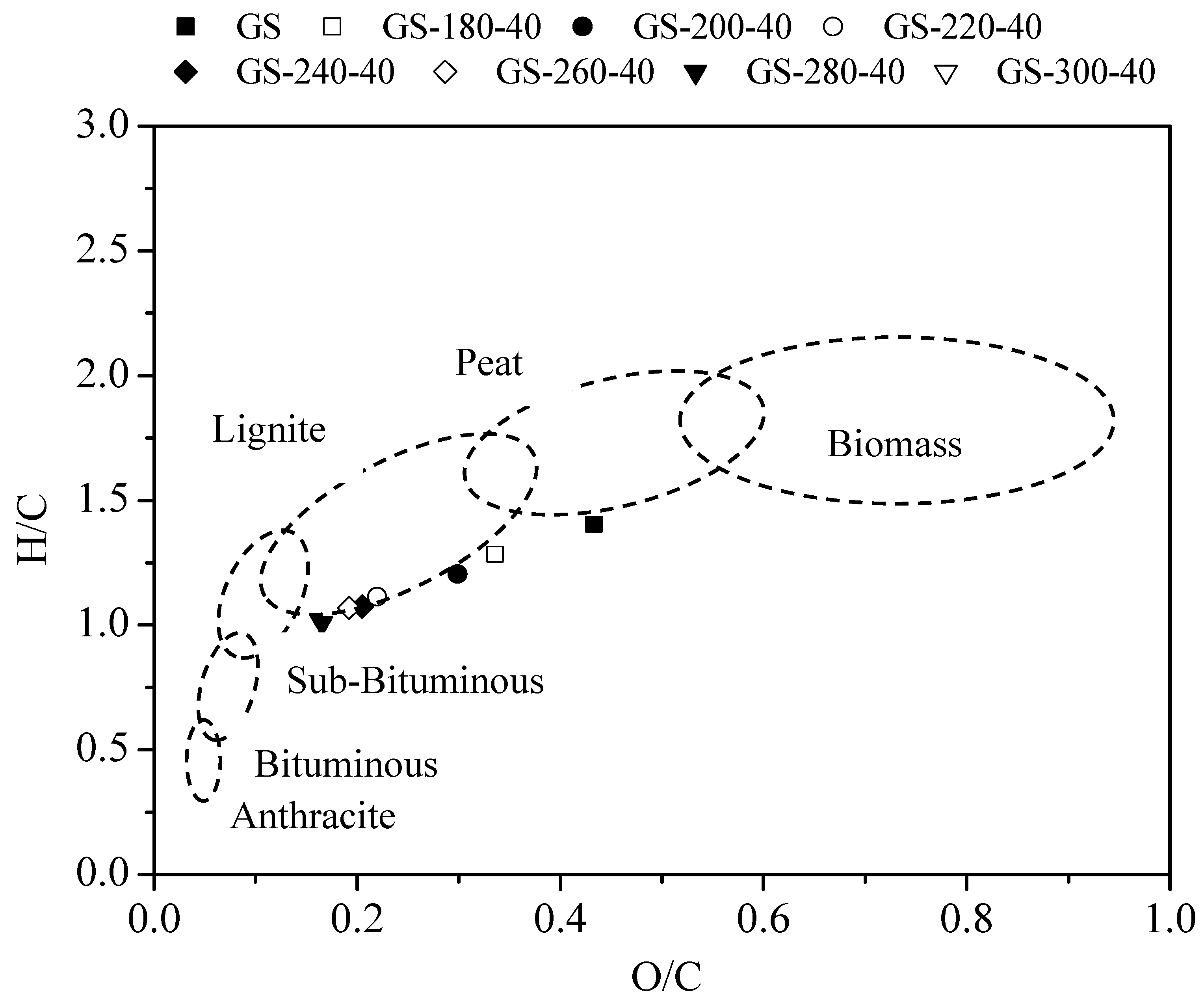
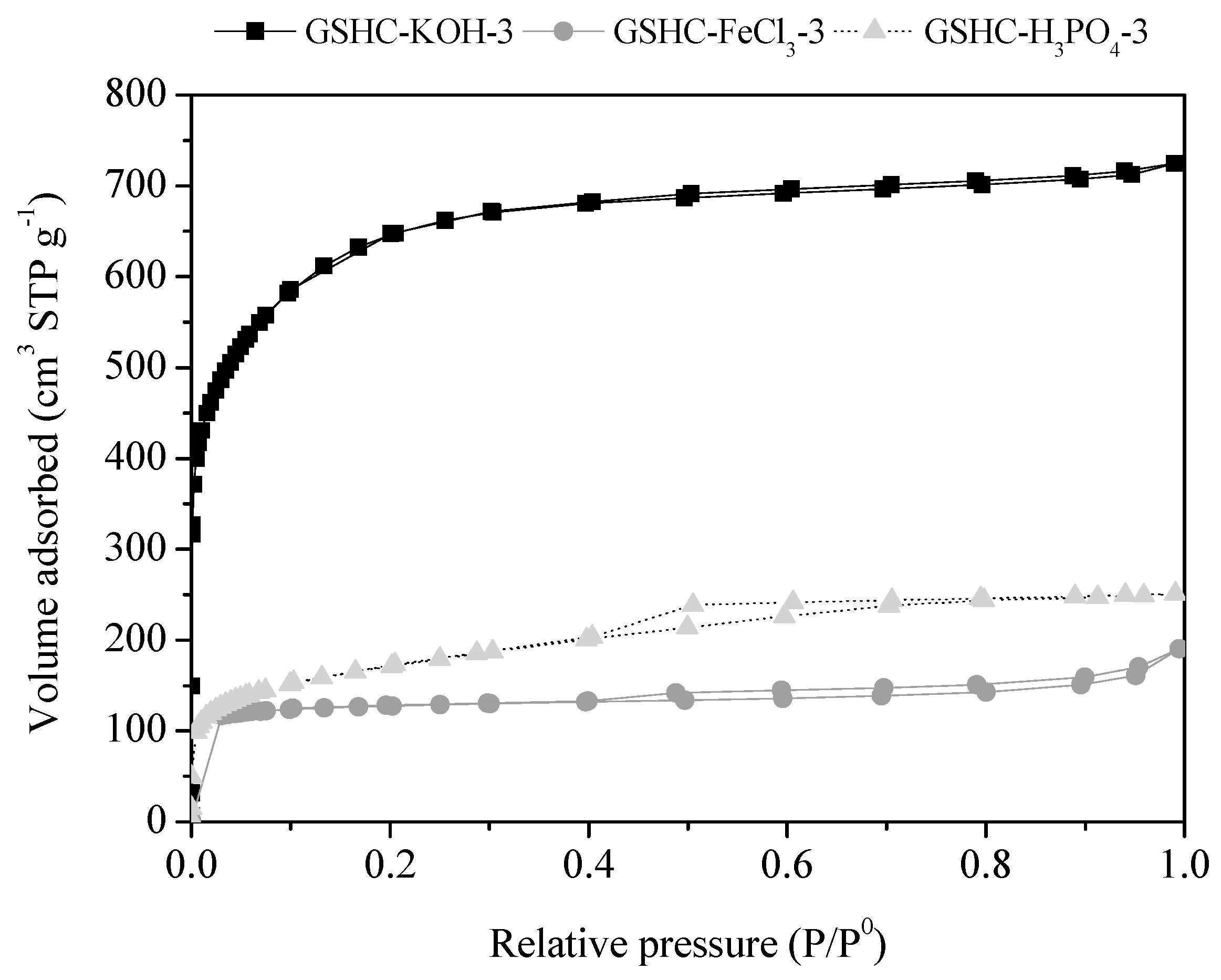
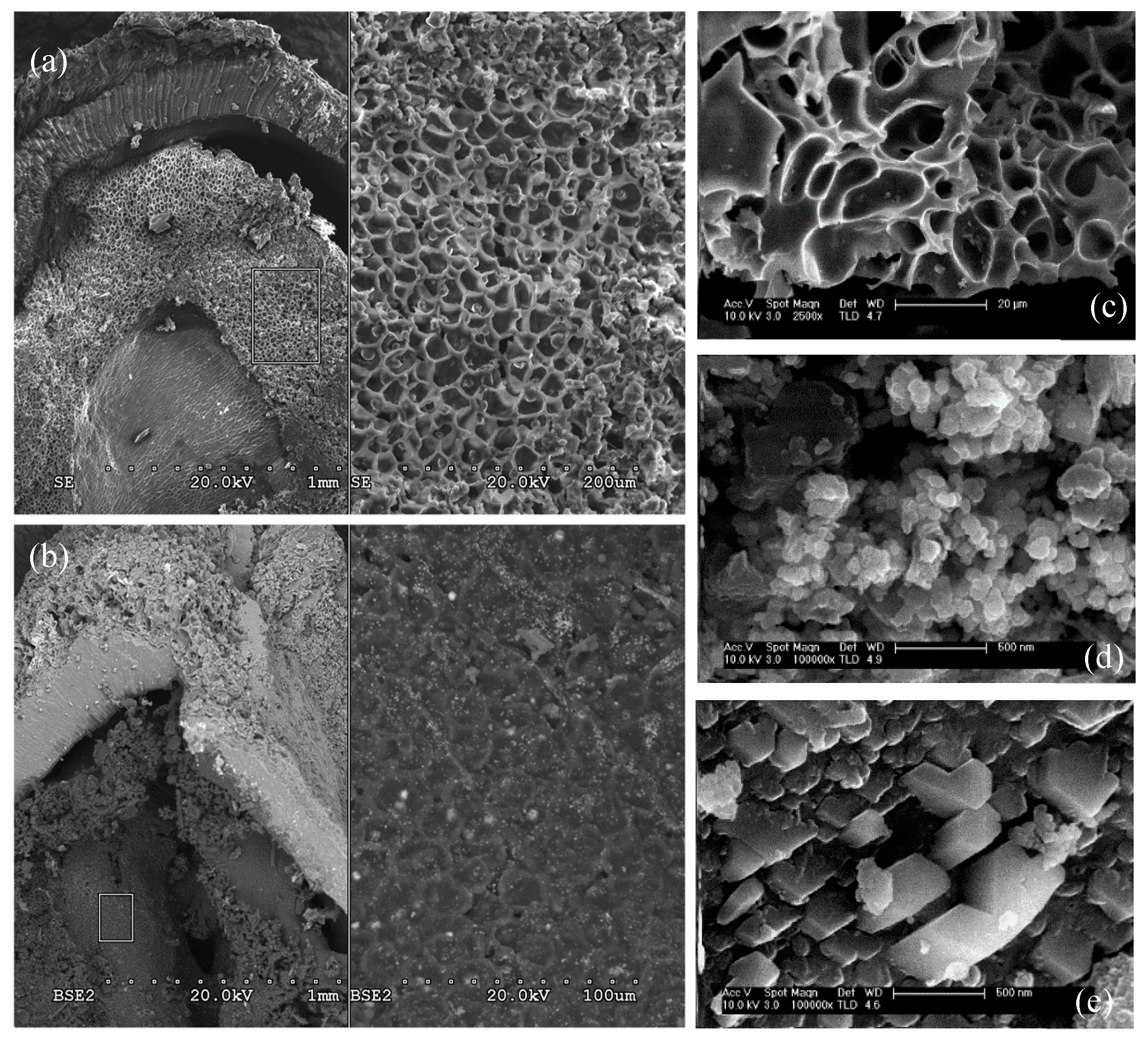
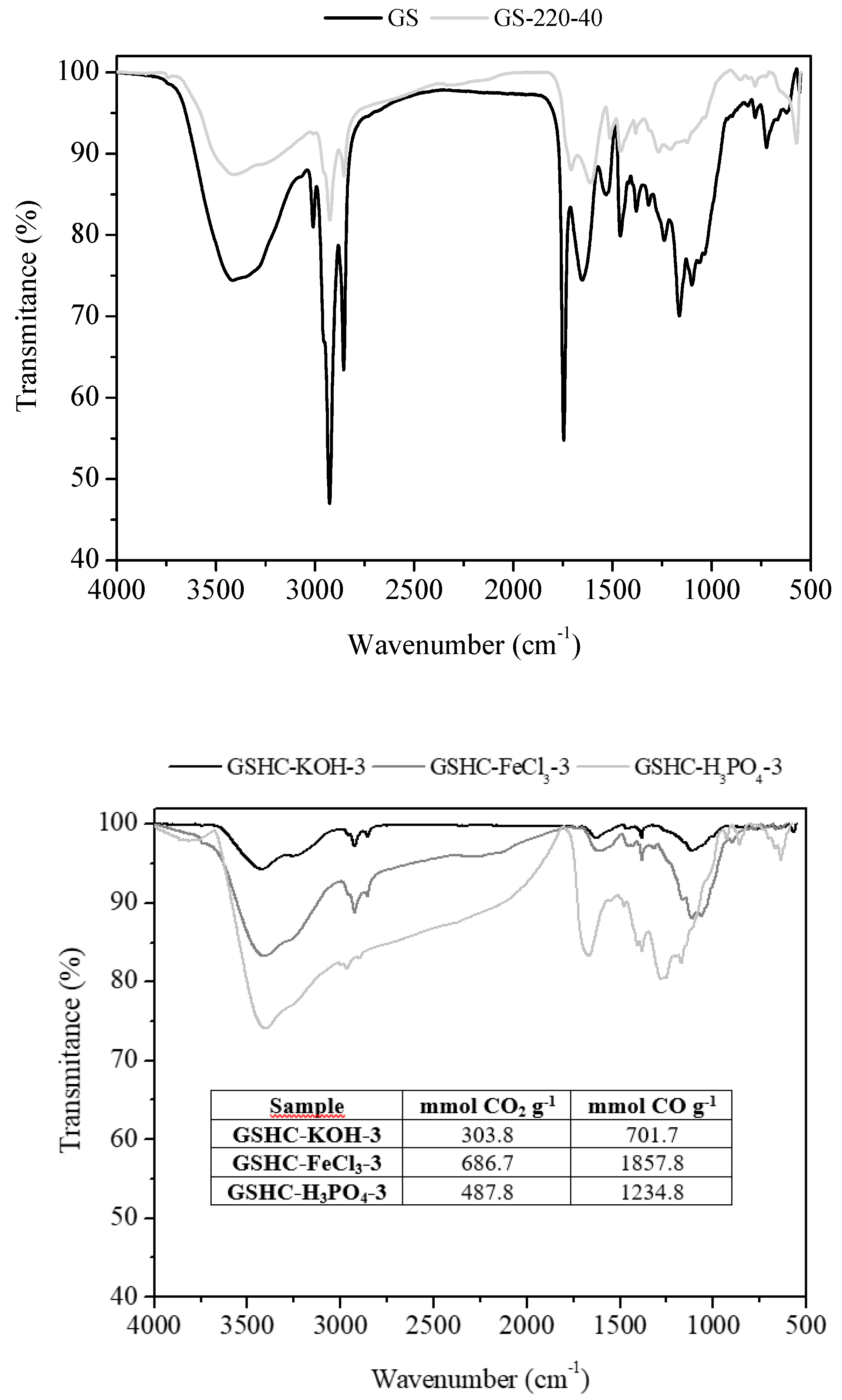
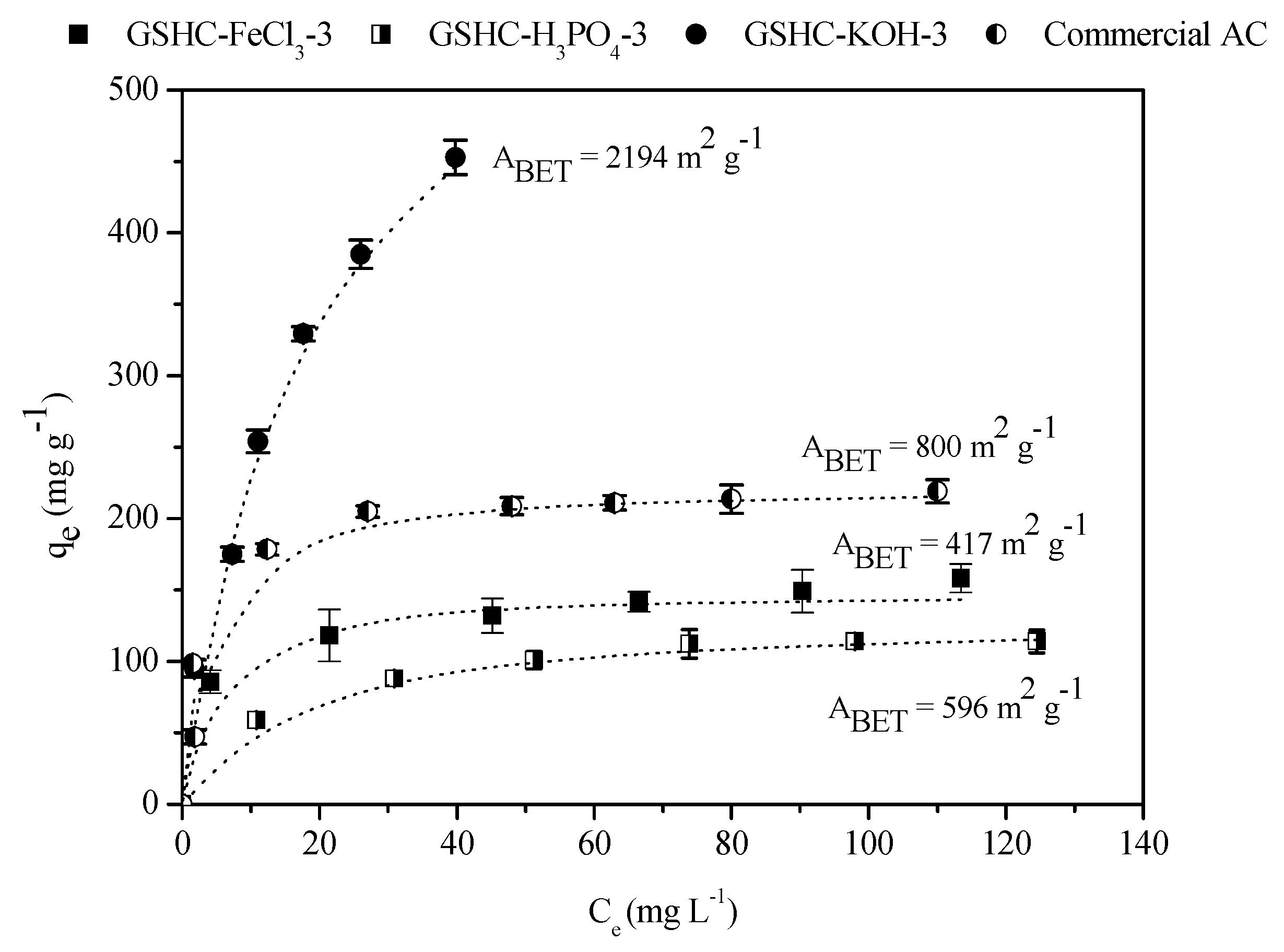
| Sample | Yield (%) | Proximate Analysis (%) | Ultimate Analysis (%) | ||||||
|---|---|---|---|---|---|---|---|---|---|
| Volatile Matter | Fixed Carbon | Ash | C | H | N | S | O 1 | ||
| GS | - | 73.3 | 24.3 | 2.4 | 56.5 | 6.6 | 1.8 | 0.13 | 32.6 |
| GS-180-40 | 75 | 66.0 | 31.0 | 3.0 | 61.7 | 6.6 | 1.6 | 0.02 | 27.1 |
| GS-200-40 | 77 | 59.2 | 37.6 | 3.2 | 63.8 | 6.4 | 1.7 | 0.01 | 24.9 |
| GS-220-40 | 59 | 55.9 | 40.7 | 3.4 | 69.0 | 6.4 | 1.7 | 0.02 | 19.5 |
| GS-240-40 | 59 | 55.2 | 41.6 | 3.2 | 69.2 | 6.2 | 2.0 | 0.02 | 19.4 |
| GS-260-10 | 53 | 50.2 | 46.8 | 3.0 | 70.5 | 6.1 | 1.7 | 0.08 | 18.6 |
| GS-260-20 | 62 | 49.8 | 46.6 | 3.6 | 70.9 | 6.4 | 1.8 | 0.04 | 17.3 |
| GS-260-30 | 64 | 50.4 | 46.3 | 3.3 | 71.2 | 6.2 | 1.9 | 0.06 | 17.4 |
| GS-260-40 | 63 | 50.3 | 46.4 | 3.3 | 70.7 | 6.3 | 1.9 | 0.05 | 17.8 |
| GS-260-50 | 62 | 49.6 | 46.8 | 3.6 | 69.8 | 6.1 | 2.0 | 0.03 | 18.5 |
| GS-260-60 | 64 | 50.6 | 45.9 | 3.5 | 70.0 | 6.2 | 2.1 | 0.02 | 18.1 |
| GS-280-40 | 62 | 47.0 | 49.8 | 3.2 | 72.6 | 6.1 | 2.2 | 0.02 | 15.9 |
| GS-300-40 | 48 | 43.8 | 51.8 | 4.4 | 74.0 | 5.8 | 2.3 | 0.01 | 13.5 |
| Sample | HHV (MJ·kg−1) | Energy Density | Energy Recovery Efficiency 1 |
|---|---|---|---|
| GS | 23.6 | - | - |
| GS-180-40 | 24.5 | 1.04 | 0.78 |
| GS-200-40 | 26.8 | 1.14 | 0.87 |
| GS-220-40 | 27.6 | 1.17 | 0.69 |
| GS-240-40 | 29.1 | 1.23 | 0.73 |
| GS-260-40 | 30.3 | 1.29 | 0.81 |
| GS-280-40 | 30.9 | 1.31 | 0.81 |
| GS-300-40 | 31.4 | 1.33 | 0.64 |
| Sample | C (wt.% Dry Basis) | Ash (wt.% Dry Basis) | ABET (m2·g−1) | Aext (m2·g−1) | Vmicro (cm3·g−1) | Vmeso (cm3·g−1) |
|---|---|---|---|---|---|---|
| GSHC-KOH-2 | 75.1 | 9.8 | 1215 | 35 | 0.57 | 0.02 |
| GSHC-KOH-3 | 73.3 | 16.3 | 2194 | 121 | 0.98 | 0.05 |
| GSHC-KOH-4 | 45.6 | 38.2 | 1780 | 260 | 0.74 | 0.18 |
| GSHC-FeCl3-2 | 51.1 | 44.4 | 394 | 44 | 0.17 | 0.02 |
| GSHC-FeCl3-3 | 49.7 | 46.0 | 417 | 54 | 0.17 | 0.02 |
| GSHC-FeCl3-4 | 35.7 | 49.2 | 312 | 50 | 0.12 | 0.02 |
| GSHC-H3PO4-2 | 63.3 | 4.6 | 654 | 255 | 0.19 | 0.23 |
| GSHC-H3PO4-3 | 61.4 | 7.6 | 596 | 242 | 0.17 | 0.21 |
| GSHC-H3PO4-4 | 69.7 | 10.8 | 590 | 172 | 0.20 | 0.16 |
| Sample | pH Slurry | qL (mg·g−1) | KL (L·mg−1) | R2 |
|---|---|---|---|---|
| GSHC-KOH-3 | 7.6 | 650.8 | 0.055 | 0.983 |
| GSHC-FeCl3-3 | 8.1 | 147.4 | 0.295 | 0.963 |
| GSHC-H3PO4-3 | 2.2 | 128.6 | 0.069 | 0.988 |
| Commercial AC | 7.7 | 221.8 | 0.296 | 0.951 |
© 2019 by the authors. Licensee MDPI, Basel, Switzerland. This article is an open access article distributed under the terms and conditions of the Creative Commons Attribution (CC BY) license (http://creativecommons.org/licenses/by/4.0/).
Share and Cite
Diaz, E.; Manzano, F.J.; Villamil, J.; Rodriguez, J.J.; F. Mohedano, A. Low-Cost Activated Grape Seed-Derived Hydrochar through Hydrothermal Carbonization and Chemical Activation for Sulfamethoxazole Adsorption. Appl. Sci. 2019, 9, 5127. https://doi.org/10.3390/app9235127
Diaz E, Manzano FJ, Villamil J, Rodriguez JJ, F. Mohedano A. Low-Cost Activated Grape Seed-Derived Hydrochar through Hydrothermal Carbonization and Chemical Activation for Sulfamethoxazole Adsorption. Applied Sciences. 2019; 9(23):5127. https://doi.org/10.3390/app9235127
Chicago/Turabian StyleDiaz, Elena, Francisco Javier Manzano, John Villamil, Juan Jose Rodriguez, and Angel F. Mohedano. 2019. "Low-Cost Activated Grape Seed-Derived Hydrochar through Hydrothermal Carbonization and Chemical Activation for Sulfamethoxazole Adsorption" Applied Sciences 9, no. 23: 5127. https://doi.org/10.3390/app9235127
APA StyleDiaz, E., Manzano, F. J., Villamil, J., Rodriguez, J. J., & F. Mohedano, A. (2019). Low-Cost Activated Grape Seed-Derived Hydrochar through Hydrothermal Carbonization and Chemical Activation for Sulfamethoxazole Adsorption. Applied Sciences, 9(23), 5127. https://doi.org/10.3390/app9235127






